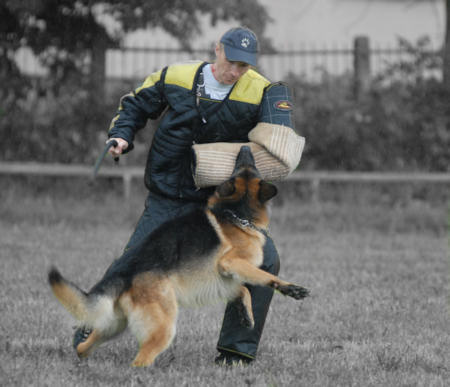How to Train a German Shepherd to Be a Guard Dog
German Shepherds will usually take to being a guard dog naturally. It's important to train them to be obedient. Learn how here. Many dogs are natural watch dogs; their bark is sufficient to alert their owner to something unusual, and the alarm they set up is a deterrent. In addition, dogs who will fight if their owner is genuinely attacked do not have to be made aggressive to do so. Training a dog specifically to be a guard dog is hazardous and potentially creates a liability for you. Misguided attempts to make a dog aggressive through abuse will only backfire because the dog will not be loyal to someone who treats them harshly, and if the dog wrongly bites someone you will be at fault. Never train dogs who are basically fearful or out of control. Such dogs may not respond appropriately in non-threatening situations.
A German shepherd dog should not be selected to receive training as a guard dog unless the dog is basically friendly, stable and clear-headed, and has been well-socialized.
STEP 1
Socialize your German Shepherd dog puppy from the start. Dogs should acquire a clear understanding of what is normal and what is not, so that they are not fearful and they know when there is a genuine threat. To socialize puppies, take them places with you, and allow them to meet and interact with as many other people and animals as possible, always taking care to keep your puppy safe from negative experiences. Dogs of any breed are prone to be shy and fearful in strange or new environments if they haven't been well socialized, and this can create a dog who bites from fear or who runs when confronted with anything unusual.
STEP 2
Enroll your German shepherd dog puppy in an obedience class as soon as possible, and train your dog thoroughly in basic obedience. It is essential that your German shepherd dog is obedient at all times, but if you want to undertake guard dog training, the need for control becomes imperative. Even though the purpose behind the training is serious, dogs should enjoy obedience work and look on it as fun. Positive reinforcement, the practice of rewarding dogs when they perform correctly rather than punishing them for mistakes, serves multiple purposes by teaching dogs obedience, bonding them with their owners and letting them have fun. It also fulfills their need to work.
STEP 3
Teach your German shepherd dog to cease barking on command. If dogs don’t learn this, they may bark incessantly at anybody and anything out of the ordinary, becoming a nuisance. Begin by teaching your dog to "Speak" on command, and give a treat and much praise for barking. Next, use a command such as “Quiet” or "Enough." Give immediate praise and a small treat when the dog is quiet. This training eventually gives you control over the dog's bark. Have your dog sit while barking. German shepherd dogs are intelligent and will normally learn quickly.
STEP 4
Encourage your dog’s bark announcing strangers who come to your house. You can develop this trait by making a show of going to see why the dog is barking, offering praise, then giving the "Quiet" or "Enough" command. React positively when your German shepherd dog alerts you to unfamiliar people or objects at home, but do not allow this behavior to develop away from home. Your dog should be unconcerned about neutral or friendly strangers you meet when you are out walking.
STEP 5
Build your dog’s alertness at home by having people the dog doesn’t know act as though they are trying to get into your home or yard. When your German shepherd dog barks, the intruder should look at the dog and then flee while you hold and praise your dog. Do not allow your pet to chase the fleeing stranger. Praise your dog highly for letting you know someone was in your territory, and stop the barking as soon as the person flees. This strengthens the dog's confidence.
STEP 6
Walk your German shepherd dog on a leash around the perimeter of your property regularly to identify your territorial boundaries. Do not allow your dog to bark at people who are outside your property. Do not allow your dog to chase people under any circumstances.
TIPS & WARNINGS
If you want to further develop your own understanding of training a dog's protection drives, seek out a responsible group such as a local schutzhund club that emphasizes creating a well-rounded working dog. These dogs are tested for sound temperament and must learn to perform at a high level in tracking and obedience as well as protection work. Find a reputable club that is a member of a national or international schutzhund organization. Before joining, spend some time learning about their organization, talking to members, and watching training sessions to determine whether you have the commitment needed to seriously engage in this demanding dog sport.
The most important aspect of guard dog training is control, which asserts your role as leader and normally comes from time you spend with your dog in enjoyable activities, including obedience training. A dog who is out of control and tries to be dominant can cause serious injuries and is far more of a liability than an asset. Never try to train your dog to bite or attack people. Doing so may be illegal in some states, and you place yourself at risk because you will be liable for injuries that result from an attack.
THINGS NEEDED
